 The Newars: Ancient Custodians of Nepal’s Cultural Heritage
The Newars: Ancient Custodians of Nepal’s Cultural Heritage
The Newars, an indigenous ethnic group of Nepal’s Kathmandu Valley, are the historical inhabitants of the region and the creators of its rich cultural and artistic legacy. With a history spanning over two millennia, the Newars have played a pivotal role in shaping Nepal’s identity through their unique customs, intricate architecture, and vibrant festivals. This ancient community, known for their entrepreneurial spirit and artistic prowess, continues to be an integral part of Nepal’s social fabric, preserving traditions while adapting to the modern world.
Historical Origins and Development
Ancient Beginnings
The Newars trace their origins to the ancient Kirat and Licchavi periods, with evidence of their presence in the Kathmandu Valley dating back to at least 300 BCE. During this time, they developed a sophisticated urban culture and established the foundations of their unique society.
Malla Dynasty Golden Age
The Malla Dynasty (13th-18th centuries) marked a golden age for Newar culture. This period saw the flourishing of art, architecture, and literature, with the construction of magnificent palaces, temples, and public spaces that still define the valley’s landscape today.
Modern Adaptations
Despite political changes and modernization, the Newars have maintained their distinct identity while adapting to contemporary society, blending traditional practices with modern lifestyles and continuing to contribute significantly to Nepal’s cultural and economic spheres.
Newar Language: Nepal Bhasa
Ancient Roots
Nepal Bhasa, the traditional language of the Newars, belongs to the Tibeto-Burman language family and has a rich literary history dating back to the 12th century. It has its own script, known as Ranjana, which is still used in religious and ceremonial contexts.
Literary Tradition
The language has a vast corpus of literature, including poetry, prose, and religious texts. Notable works include the “Naradsmriti” and “Amarkosh,” which have significantly contributed to the preservation of Newar culture and knowledge.
Modern Challenges
Despite its historical importance, Nepal Bhasa faces challenges in the modern era. Efforts are being made to revitalize the language through education programs, publications, and media to ensure its survival and continued relevance in Newar communities.
Newar Architecture: A Living Heritage
Distinctive Style
Newar architecture is characterized by its unique blend of indigenous, Tibetan, and Indian influences. Multi-tiered pagoda-style temples, intricate wood carvings, and brick-and-timber constructions are hallmarks of this architectural tradition. The use of terracotta, carved wood, and metal work showcases the Newars’ exceptional craftsmanship.
Iconic Structures
The Kathmandu Valley is dotted with iconic Newar structures, including the Nyatapola Temple in Bhaktapur, the Kasthamandap in Kathmandu, and the Krishna Mandir in Patan. These buildings not only serve religious and social functions but also stand as testaments to the Newars’ architectural genius.
Urban Planning
Newar urban planning is exemplified in the layout of traditional towns, featuring central Durbar Squares surrounded by residential areas, interconnected by a network of courtyards (bahas) and streets. This design fosters community interaction and reflects the Newar philosophy of harmonious living.
Newar Arts and Crafts
Metalwork
Newar artisans are renowned for their exquisite metalwork, particularly in bronze and copper. They create intricate statues of deities, ritual objects, and everyday items using the lost-wax casting technique, a method passed down through generations.
Wood Carving
Wood carving is an integral part of Newar architecture and art. Elaborately carved windows, doors, and pillars adorn buildings, showcasing scenes from mythology, nature, and daily life. The precision and detail in these carvings reflect the skill and patience of Newar craftsmen.
Paubha Painting
Paubha, a traditional religious painting style, is a hallmark of Newar art. These intricate paintings, often depicting Buddhist and Hindu deities or mandalas, are created using natural pigments on cotton or silk canvas. The art form requires immense skill and spiritual dedication.
Newar Festivals: A Year-Round Celebration
Indra Jatra
One of the most important Newar festivals, Indra Jatra, is an eight-day celebration honoring Indra, the god of rain. The festival features the display of Akash Bhairav’s mask, the chariot procession of Kumari (the living goddess), and numerous masked dances that bring the streets of Kathmandu to life.
Bisket Jatra
Celebrated in Bhaktapur to mark the Newar New Year, Bisket Jatra involves the spectacular tug-of-war of two massive chariots through the narrow streets. The festival culminates with the erection of a towering wooden pole, symbolizing the triumph of good over evil.
Machhindranath Jatra
This month-long festival honors the god of rain and compassion. The highlight is the procession of a massive chariot carrying the deity’s image through the streets of Patan. The festival showcases the Newars’ devotion and their intricate ritual practices.
Gai Jatra
A unique festival blending humor with remembrance, Gai Jatra honors those who have passed away in the previous year. Families parade cows (or children dressed as cows) through the streets, while satirical performances and jokes critique social and political issues.
Newar Cuisine: A Gastronomic Journey
| Dish | Description | Occasion |
| Samay Baji | A set of dishes including beaten rice, meat, lentil patties, and spices | Festivals and ceremonies |
| Yomari | Steamed rice flour dumplings with sweet fillings | Yomari Punhi festival |
| Choila | Spicy grilled meat, typically buffalo | Everyday and special occasions |
| Wo | Lentil pancakes | Everyday breakfast |
| Lakhamari | Sweet deep-fried bread | Festivals and special events |
Newar Social Structure and Caste System
Complex Hierarchy
The Newar social structure is characterized by a complex caste system that combines elements of both Hindu and Buddhist traditions. This unique system includes over 64 castes and sub-castes, each with specific roles and occupations within the community.
Priest Castes
At the top of the hierarchy are the priest castes, including the Hindu Rajopadhyaya Brahmins and the Buddhist Vajracharya and Shakya. These groups are responsible for performing religious rituals and maintaining spiritual traditions.
Occupational Castes
Various occupational castes follow, such as the Shrestha (administrators and traders), Maharjan (farmers), and Tamrakar (coppersmiths). Each caste traditionally has specific duties and crafts, contributing to the community’s economic and cultural fabric.
Modern Adaptations
While the caste system still influences social interactions and marriage practices, its rigid boundaries have softened in modern times. Many Newars now pursue diverse professions regardless of their traditional caste occupations, adapting to contemporary socio-economic realities.
Newar Rituals and Life Cycle Ceremonies
Machabu Bhuigu
This ritual marks a newborn’s first contact with the earth. Performed on the 11th day after birth, it involves placing the baby on the ground and worshipping the earth deity, symbolizing the child’s connection to nature and community.
Annaprashana
The rice-feeding ceremony, typically held when a child is six months old, marks the beginning of solid food consumption. It’s a joyous occasion where family and community members gather to bless the child’s transition to a new stage of life.
Ihi
A unique pre-puberty ritual for Newar girls, Ihi is a symbolic marriage to the Bel fruit, representing the god Vishnu. This ceremony is believed to protect girls from widowhood in their actual marriages later in life.
Ghasu
The Newar death ritual is an elaborate 13-day process involving various purification rites and feasts. It concludes with the Ghasu ceremony, where the deceased’s soul is symbolically guided to the afterlife through intricate rituals and offerings.
Preserving Newar Heritage in the Modern World
Cultural Education
Efforts are being made to integrate Newar language, history, and cultural studies into school curricula. Community organizations and cultural institutions offer workshops and classes to teach traditional arts, crafts, and performing arts to younger generations, ensuring the continuity of these practices.
Urban Conservation
Initiatives to preserve and restore Newar architectural heritage are ongoing, with UNESCO World Heritage Site designations helping to protect key areas. Urban planning policies are being developed to balance modernization with the preservation of traditional Newar town layouts and building styles.
Digital Preservation
Technology is being harnessed to document and digitize Newar cultural artifacts, manuscripts, and oral traditions. Online platforms and social media are used to promote Newar culture globally, connecting diaspora communities and fostering cultural pride among younger Newars.
This was generated with the help of AI. This technology is new and constantly improving. Please verify the accuracy before sharing.
